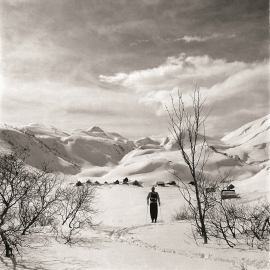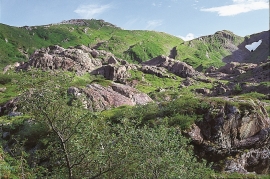Published: 06.09.2015 | Author: Haakon Fossen
Kvamskogen, toward the north. (Svein Nord)
MOUNTAIN TURNED UPSIDE DOWN
The different bedrock types that got shoved in over Hordaland in Cambro-Silurian times still remain, layer by layer, almost like a cake. But at Kvamskogen the cake has been turned upside down.
During the collision with Greenland, over 400 million years ago, different types of bedrock units, thrust sheets, were shoved up on top of each other. Those from nearest the earth's crust ended up underneath crust that had been transported in from a long distance. On top, throughout most of Hordaland, lies a thrust sheet that had been transported from a long way away. These so-called “exotic rock types” are greenish and come from an old marine area that once existed between Greenland and Norway in Cambro-Silurian times. But, in Kvamskogen and in the mountains north of Norheimsund and Øystese, the geological layers have been turned upside down. The exotic rock types do not lie on top, as they normally do - In these areas other types of bedrock rest on top of the greenish rocks; the thrust sheets of the Bergsdals Complex reigns highest in Kvamskogen.
The upside down cake is especially clearly visible in Steinskvanndalen. The road into the valley lies on the exotic, green rocktypes (mica schist and greenschist). The surrounding bedrock is Precambrian basement belonging to the Bergsdals Complex, which lies on top of the green bedrocks.
The reason for this layering is a big overturning during the mountain building event. The overturning resulted in a large tongue of the Bergdals Complex being folded into the overlying exotic bedrocks. Only the lowermost part of this tongue is visible today. The quartz-rich and hard rock types in the Bergdals Complex remain and form the beautiful mountain that now overlies the green bedrocks.
In winter, Mødalen and Såta are popular tourist attractions. Large amounts of precipitation fall over the whole Kvamskogen area, often as snow. (Alf Adriansen)
Serpentinite
Uppermost in Mødalen, toward Såta, there are a several bedrock outcrops of serpentinite in Cambro-Silurian layers. In a few places this stone has been transformed into soft soapstone. People have carved their names into it with a knife. In fractures within the serpentinite there is also a fibrous asbestos mineral. (Haakon Fossen)
- Fossen, H. 1993. Structural evolution of the Bergsdalen Nappes, Southwest Norway. Norges Geologiske Undersøkelse 424:23–50.
- Kvale, A. Petrologic and structural studies in the Bergsdalen quadrangle, western Norway. Bergen Museums Årbok 1946–47,Naturvit.rekke,1.
- Rekstad, J. 1911. Geologiske iagtagelser fra nordvestsiden av Hardangerfjorden. Norges geologiske undersøgelse.






